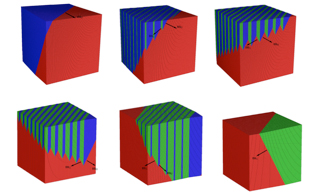AEM Researchers "Break the Rules"
Richard James wrote commentary articles recently in Nature [vol. 521, 298-299 (21 May 2015)] and Science [29 May 2015 348 (6238): 968-969] that relate closely to research carried out in AEM over the past few years. These articles both concern the perplexing problem of understanding hysteresis in materials.

In one case, this is magnetic hysteresis [Nature]; in the other it is hysteresis and reversibility of phase transformations [Science]. Generally, hysteresis is the phenomenon whereby the material has a higher transformation temperature on heating than on cooling, or, in the magnetic case, the magnetization of a material occurs on a different path while increasing the magnetic field than while decreasing the field. Graphs of measured properties such as % of one phase vs. temperature or, in the magnetic case, magnetization vs. magnetic field, have loops called “hysteresis loops”.
James perspective in Science comments on a “breathtaking” discovery from researchers in the laboratory of Eckhard Quandt (Kiel, Germany) and Manfred Wuttig (University of Maryland) [Science 29 May 2015: 348 (6238), 1004-1007]. The lead author is graduate student Christoph Chluba. They discover new shape memory alloys in the system TiNiCuCo which undergo 10 million cycles of stress-induced phase transformation. The tests are done under some of the most demanding conditions imaginable: each cycle involved complete (macroscopic) transformation produced by a peak tensile stress of 400 MPa. This is a big stress, about twice the yield stress of a typical structural steel. Remarkably, the behavior of the material in cycle 1 is nearly identical to its behavior in cycle 10 million.
What is even more interesting, and closely relates to AEM research, is that the alloy very closely satisfies certain conditions of compatibility called the "cofactor conditions" discovered in James group, and theorized to be important for low hysteresis and high reversibility. The first announcement of these conditions came from Jerry Zhang’s research of 2006 [http://www.aem.umn.edu/~james/research/publications.html]
and members of James’ group have developed and studied these conditions. In particular, a 2013 article in the Journal of Mechanics and Physics of Solids (ibid.) by graduate students/postdocs Xian Chen, Vijay Srivastava, Vivek Dabade revealed remarkable implications of these conditions for the fitting together of phases without stressed transition layers.
The first “cofactor alloy”, Zn45Cu25Au30, was discovered by these members of James’ group, together with postdoc and former graduate student Yintao Song and AEM Professor Thomas Shield, and published in Nature [vol. 502, 85-88 (03 October 2013)]. At that time this ZnCuAu alloy exhibited unprecedented reversibility, but the Quandt/Wuttig alloy in some ways eclipses it by a large margin.
These cofactor conditions provide a blueprint for the discovery of new highly, reversible phase transformations. And use of the cofactor conditions to search for new “cofactor alloys” is a systematic approach that can be applied to new cases. However, some of the Quandt/Wuttig alloys have another feature that may be important. They contain nontransforming precipitates which also aid in the strengthening of the alloy. The current view is that these precipitates, epitaxial to both phases, underlie the remarkable reversibility. Further research is needed, but the importance of these results is undeniable.
These results are also of significant importance to technology, particularly in the medical, energy and microelectonic sectors. People developing new technologies have largely avoided materials with big first order phase transformations, because of reliability issues. These new results appear to overcome these problems. Nevertheless, by avoiding many transformation cycles or working under very small strains, the medical device industry now bases a > $ 5 billion market on devices that use the (unexceptional) shape memory alloy NiTi.
Particularly interesting are alloys that undergo a shape changing transformation, but also have diverse magnetoelectric or optical properties. Because these properties are sensitive to lattice distortion, they can be turned on and off by the phase transformation. For example, one phase can be a strong magnet and the other nonmagnetic. Turning on and off magnetism can be used, for example, as a method of the direct conversion of heat to electricity, as reported in AEM News (AEM Spotlight Archives, 2011-03-28). Other potential areas that can benefit from highly reversible phase transformations are information storage, solid-state refrigeration, active photonic devices (with applications to e.g., smart windows), and new kinds of noninvasive medical devices and sensors.
The new understanding of magnetic hysteresis could also have profound benefits to society, especially in the energy sector. The electrification of vehicles, which is already well underway, could benefit from new magnetic materials with big hysteresis loops, as main components of many electric motors. Magnetic materials with tiny hysteresis loops could also benefit from this new understanding, as they are ubiquitous components of the transformers and power electronic devices that control the flow of electricity on the grid.
An interesting fact about the cofactor and related conditions is that they were discovered by theory. It is quite unusual that discovery of entirely new materials follows rules of synthesis based on mathematical theory. Of course, many, many alloys of transforming materials were made previous to these discoveries. Why did they not happen to hit the compositions corresponding to satisfaction of the cofactor conditions? Apparently this is because one has to be extremely close to the composition defined by the cofactor conditions to see the dramatic effect.
Postdocs (and former graduate students) from AEM that participated in this research are now at Medtronic (Zhang), GE Global Research (Srivastava), Lattice Engine (Song), Advanced Light Source/Caltech/Hong Kong University of Science and Technology (Chen). Vivekanand Dabade is a current graduate student investigating both very large and very small hysteresis in magnetic materials. The research was supported by NSF-PIRE (OISE-0967140), AFOSR-MURI (FA9550-12-1-0458) and ONR (N00014-14-1-0714).
Last Modified: 2015-06-03 at 18:44:11 -- this is in International Standard Date and Time Notation


